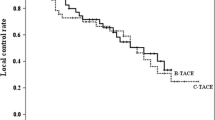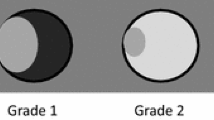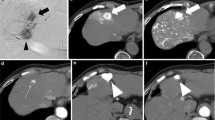Abstract
Purpose
To reveal the mechanism of dense accumulation of lipiodol emulsion (LE) in hepatocellular carcinoma (HCC) during selective balloon-occluded transarterial chemoembolization (B-TACE).
Methods
Balloon-occluded arterial stump pressure (BOASP) at the embolization portion was measured during selective B-TACE for 43 nodules in 42 patients. Fluoroscopy and digital subtraction angiography were prospectively observed during selective B-TACE to note whether dense LE accumulation in HCC occurred. The LE concentration ratio of HCC to embolized liver parenchyma (LECHL ratio) was also calculated for each treatment on the basis of the computed tomographic scan obtained immediately after selective B-TACE. The relationships between degree of LE accumulation and the BOASP, as well as the LECHL ratio, were analyzed.
Results
Arterial flow beyond the catheter tip was maintained even after balloon inflation. In 39 of 43 treatments, LE inflow into the nontumorous liver parenchyma ceased immediately after LE droplets were filled in arteries of the nontumorous liver parenchyma while LE inflow into the HCC nodule continued (group 1). More dense LE accumulation in HCC nodule was obtained in these 39 treatments. In four treatments, LE inflow both into the nontumorous liver parenchyma and into the HCC nodule continued, and no dense LE accumulation in HCC nodule was observed (group 2). In these four treatments, thick anastomotic vessels with collateral artery were noted. The BOASP in group 1 was (mean ± SD) 33.8 ± 12.8 mmHg (range 13–64 mmHg) and that in group 2 was 92.3 ± 7.4 mmHg (range 83–100 mmHg). There was a statistically significant difference in BOASP between groups (p = 0.00004, Welch’s t test). The LECHL ratio in group 1 was 18.3 ± 13.9 (range 2.9–54.2) and that in group 2 was 2.6 ± 1.1 (range 1.7–4.2). There was a statistically significant difference in the LECHL ratio between the groups (p = 0.000034, Welch’s t test).
Conclusion
Selective B-TACE induced dense LE accumulation in HCC nodules in 39 (91 %) of 43 treatments in which BOASP was 64 mmHg or less.






Similar content being viewed by others
References
Llovet JM, Bruix J (2003) Systematic review of randomized trials for unresectable hepatocellular carcinoma: chemoembolization improves survival. Hepatology 37:429–442
Lo CM, Ngan H, Tso WK et al (2002) Randomized controlled trial of transarterial lipiodol chemoembolization for unresectable hepatocellular carcinoma. Hepatology 35:1164–1171
Irie T, Kuramochi M, Takahashi N (2009) Improved accumulation of lipiodol under balloon-occluded transarterial chemoembolization (B-TACE) for hepatocellular carcinoma: measurement of blood pressure at the embolized artery before and after balloon inflation. IVR 26:49–54
Cho KJ, Lunderquist A (1983) The peribiliary vascular plexus: the microvascular architecture of the bile duct in the rabbit and in clinical cases. Radiology 147:357–364
Tohma T, Cho A, Okazumi S et al (2005) Communicating arcade between the right and left hepatic arteries: evaluation with CT and angiography during temporary balloon occlusion of the right or left hepatic artery. Radiology 237:361–365
Ekataksin W (2000) The isolated artery: an intrahepatic arterial pathway that can bypass the lobular parenchyma in mammalian livers. Hepatology 31:269–279
Nakamura H, Hashimoto T, Oi H, Sawada S (1988) Iodized oil in the portal vein after arterial embolization. Radiology 167:415–417
Kan Z, Ivancev K, Hägerstrand I et al (1989) In vivo microscopy of the liver after injection of lipiodol into the hepatic artery and portal vein in the Rat. Acta Radiol 30:419–425
Moriyasu F, Nishida O, Ban N et al (1986) “Congestion index” of the portal vein. AJR Am J Roentgenol 146:735–739
Demachi H, Matsui O, Abo H, Tatsu H (2000) Simulation model based on non-newtonian fluid mechanics applied to the evaluation of the embolic effect of emulsions of iodized oil and anticancer drug. Cardiovasc Intervent Radiol 23:285–290
de Baere T, Zhang X, Aubert B et al (1996) Quantification of tumor uptake of iodized oils and emulsions of iodized oils: experimental study. Radiology 201:731–735
Raoul JL, Bourguet P, Bretagne JF et al (1988) Hepatic artery injection of I-131-labeled lipiodol. Part I. Biodistribution study results in patients with hepatocellular carcinoma and liver metastases. Radiology 168:541–545
Lau WY, Lai ECH, Leung TWT, Yu SCH (2008) Adjuvant intra-arterial iodine-131-labeled lipiodol for resectable hepatocellular carcinoma: a prospective randomized trial—update on 5-year and 10-year survival. Ann Surg 247:43–48
Chua TC, Chu F, Butler SP et al (2010) Intra-arterial iodine-131-lipiodol for unresectable hepatocellular carcinoma. Cancer 116:4069–4077
Miyayama S, Matsui O, Yamashiro M et al (2007) Ultraselective transcatheter arterial chemoembolization with a 2-F tip microcatheter for small hepatocellular carcinomas:relationship between local tumor recurrence and visualization of the portal vein with iodized oil. J Vasc Interv Radiol 18:365–376
Conflict of interest
The authors declare that they have no conflict of interest.
Author information
Authors and Affiliations
Corresponding author
Electronic supplementary material
Below is the link to the electronic supplementary material.
Supplementary material 1 (MOV 1595 kb)
Supplementary material 2 (MOV 4609 kb)
Rights and permissions
About this article
Cite this article
Irie, T., Kuramochi, M. & Takahashi, N. Dense Accumulation of Lipiodol Emulsion in Hepatocellular Carcinoma Nodule during Selective Balloon-occluded Transarterial Chemoembolization: Measurement of Balloon-occluded Arterial Stump Pressure. Cardiovasc Intervent Radiol 36, 706–713 (2013). https://doi.org/10.1007/s00270-012-0476-z
Received:
Accepted:
Published:
Issue Date:
DOI: https://doi.org/10.1007/s00270-012-0476-z




